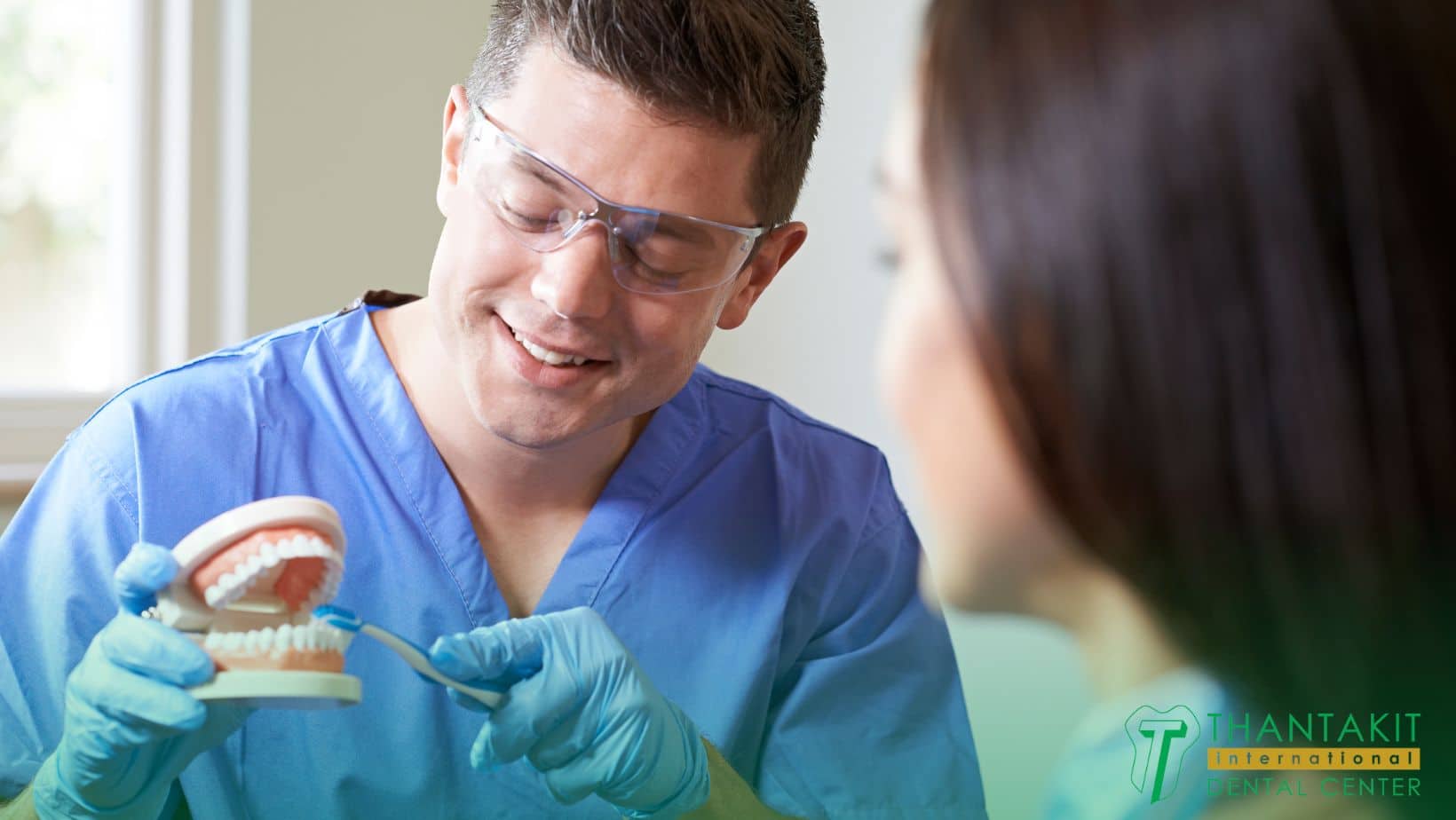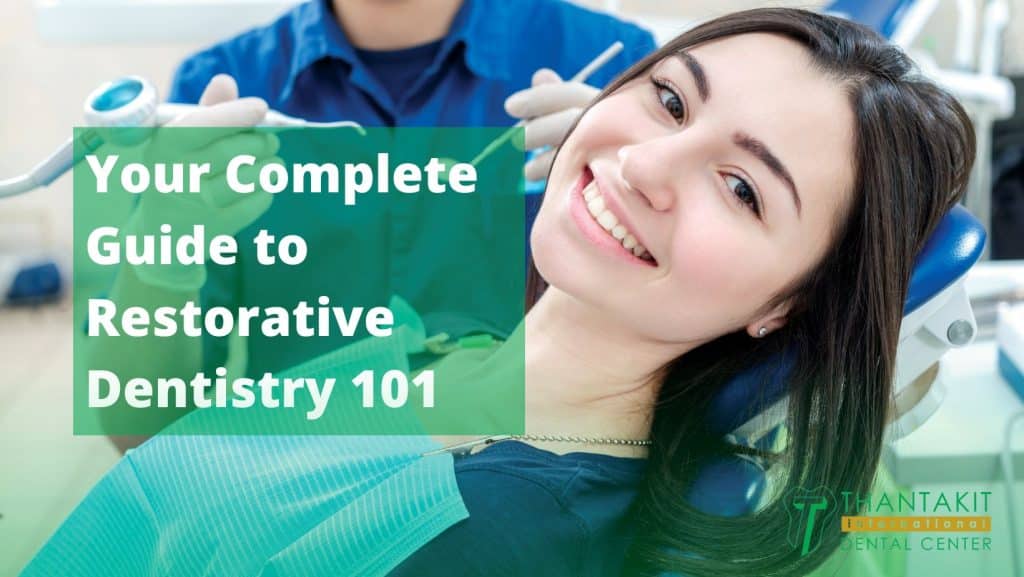Restorative Dentistry: A discussion on the different types of restorative dental treatments, including dental crowns, bridges, and fillings.
Do you have missing or broken teeth? Does it include dental caries or cavities? What about receding gums? If you wish to repair or restore damaged teeth, that’s when you avail of restorative dentistry.
Its main goal is to improve chewing function and overall oral health on top of restoring the aesthetic or cosmetic look of your teeth. It’s about form and function restoration, in other words.
Page Contents
What is Restorative Dentistry?
Restorative Dentistry, as its name suggests, is dentistry that restores damaged parts of your mouth, like teeth and gums. It’s the dentistry branch mostly concerned with the repair and replacement of damaged and missing teeth.
The most common types of dental restoration include crowns, bridges, and implants. It also includes teeth fillings, teeth whitening, and dental bond (gluing broken parts of teeth together or bonding them together with a crown or denture).
Who Performs Restorative Dentistry to Whom?
The general practitioner of the dental world—the general dentist, also known as the family dentist—typically does restorative dentistry on patients. They put in fillings on cavities, insert inlays/onlays on bigger cavities, or put in crowns, bridges, or implants for worn-down teeth.
You can even depend on them when prescribing the right dentures for senior citizens who are too old to undergo implant surgery or orthodontics for children who wish to straighten crooked teeth before undergoing puberty.
You may require this type of dentistry if you suffer from the following:
-
Cavities or tooth decay.
-
Damaged or broken teeth.
-
Missing teeth (fallen off or otherwise extracted by the dentist).
Other oral issues—such as receding gums, periodontal disease, gingivitis, and so on and so forth—are also dealt with using restorative dentistry in the form of deep cleaning, scaling, and root planing.
You’ll be referred to a dental surgeon if you require outright gum grafting or gum flap surgery. In turn, restorative dentistry is notably different from cosmetic dentistry procedures such as teeth whitening.

Why is Restorative Dentistry Important?
If you wish to end up with oral health that remains superb even as you age, you can preserve damaged teeth with restorative dentistry. The dentist of your choice can then restore your teeth to full function and your smile to full aesthetic form in short notice.
It’s even better to prevent tooth decay and damage, but even brushing can only do so much. In fact, if you brush wrong or brush too hard, this can also wear down your teeth leading to sensitivity and damage.
You can’t help yourself. To err is to be human. It’s just fortunate that the dentistry industry has you covered in the form of restorative dentistry that improves or restores your ability to chew, speak, eat, drink, swallow, and so forth.
What are the Advantages of Restorative Dentistry?
There are many advantages to availing of restorative dentistry. For example, it gives you the following features and benefits.
-
It restores oral health.
-
It gets rid of dental pain.
-
It improves chewing function.
-
It reduces your risk of future dental issues.
-
It improves the look and feel of your smile.

What are the Types of Dental Restoration?
The most common types of dental restorations are fillings and crowns plus everything in between. Which one should you get? It depends on a case-by-case basis. What do your teeth or does your oral health require?
-
Fillings: Tooth decay happens when you allow plaque to form unchecked on teeth surfaces. This film is composed of bacteria, starch, and sugars, which produces acid waste products. This acid then eats away at the minerals of your teeth enamel.
Once enough enamel is eaten away, that’s when holes or cavities form on your teeth. You can fix smaller cavities with dental fillings, in the same way that cement or asphalt can fix potholes on the street. This procedure involves drilling away the tooth’s decayed portion.
He then fills the hole with composite material that’s the same color as your tooth to hide the hole. This halts tooth decay progression and reduces additional risk for damage down the line.
-
Crowns or Caps: Dental crowns are a type of denture or tooth restoration that repairs larger cavities or restores a broken tooth back to health. It’s called a crown because it’s placed atop the tooth like a king’s crown or a cap (it’s also known as that).
It uses the original holey or damaged tooth as the base or foundation for it. Otherwise, it’d use the neighboring healthy/unhealthy teeth to anchor it to your jaw. You’re sacrificing the original enamel for the porcelain structure of the crown.
The crown fits over the entire tooth even though it’s called a cap or crown. Crown placement also entails shaving off the natural tooth’s enamel to make the crown perfectly fit over the tooth it’s restoring.
There’s also the option to put in a dental implant on the empty tooth socket and jaw to serve as the new anchor. More on this later.
-
Inlays and Onlays: In between the filling and the crown are inlays and onlays. They’re used for cavities too deep or too wide to be fixed with tooth filling but aren’t big enough to justify the use of a crown or cap. They’re like partial crowns the shape of the cavities they’re meant to fill.
They’re custom restorations that involve getting a mold of the cavity or damaged tooth before they’re customized to fit the negative space of the mold. They’re supposed to fit like puzzle pieces that are glued together with bonding material.
The dentist permanently glues the inlay (placed inside the cavity of your tooth to fill in deep gaps) or onlay (placed on the cusp of the tooth to fill in wide gaps) onto the tooth with the dental glue.
The onlay covers the wider damage while the inlay deals with deeper damage. If the damage gets too wide, you might need to get a cap or crown altogether. If it’s deep enough to penetrate the tooth root, an endodontic (root canal) treatment might be called for.
-
Bridges: A bridge uses one or two or more teeth from opposing sides of it to suspend an artificial tooth or crown over the empty space where a tooth or teeth used to be. It replaces either a single extracted or missing tooth. It can also replace a whole row of teeth.
It’s usually anchored by a nearby tooth (cantilever bridge) or standard opposing teeth (standard bridge) by sacrificing them and shaving their enamel down to fit right inside the hollow dental cap. The other non-hollow artificial tooth is suspended over the gum of the missing tooth (or teeth).
Aside from the dentist shaving down the enamel of neighboring teeth to fit in the supporting crowns, he can also insert them into dental implants instead to spare the teeth from the shave down.
The crowns can fit into shorn teeth or over a dental implant with an abutment that fills in the gap between the hollow crown and the metal stud jutting out of the gum where the implant was placed.
-
Root Canal Treatment: A root canal treatment or therapy, also known as an endodontic treatment, is a surgical procedure to remove an infected tooth root or pulp from the tooth, thus inducing tooth death. From there, inert material is pumped into the empty chamber.
Finally, the shell of what was left of the tooth is shaved down to make way for the crown or a simple filling. Some dentists attempt to save the tooth by pumping it full of antibiotics until the swelling and severe nerve pain subsides. However, others opt for nerve and root removal.
It’s because when bacteria has reached the tooth pulp, it causes an agonizing infection that will sooner or later lead to tooth death anyway. The root canal is your mercy kill to that tooth and it’s a way to save it from outright extraction as well.
When removing the pulp, this includes any blood vessels and tiny nerves still inside the tooth. It should be cleaned out of biological matter until only the shell remains. It should also be cleaned and disinfected prior to placement of inert material.
The material could be gutta-percha, a rubbery dental material. It could be any other number of things to cement the inside of your hollowed tooth to prevent bacterial spread from the inside.
-
Dental Implants: A dental implant is a small metal screw embedded unto the empty socket of where your missing teeth used to be. This threaded post screws itself tight into the bone and you’ll have a healing period as it becomes one with the jaw.
It should have a metal part jutting out from under the gum. This is where you can place your abutment and crown. The implant serves as your tooth root replacement so that your crown denture feels like a natural tooth without using any bridges.
On that note, you can restore whole rows of missing teeth by putting in dental implants on either side then placing bridges onto those implants. You don’t need to place implants on every missing tooth—just put two implants on either edge of the bridges to serve as its support.
A dental implant allows you to place dentures, bridges, and crowns over your mouth without altering any of your natural neighboring teeth left. They can also be used on mouths that don’t have any natural teeth remaining as well.
-
Dentures or False Teeth: This traditional option involves placing temporary false teeth over your gums with dental glue for aesthetic and functional purposes. They’re much cheaper than getting a dental implant, bridge, or crown.
You can also use full dentures to replace an entire arch of missing teeth. Permanent or non-removable dentures typically involve placement over the arch using four to six strategically placed dental implants though.
Meanwhile, partial dentures replace missing teeth in specific areas of your mouth. They’re like bridges except they don’t require you to shave your natural teeth to place them on your mouth. They’re instead glued atop gums or worn like mouth guards.
The jawbone under them serves as their support. The implant-supported dentures offer full natural teeth functionality though. However, most senior citizens couldn’t take the surgery needed for all-on-6 implants, so they opt for temporary or conventional dentures instead.

What’s the Difference Between Restorative and Cosmetic Dentistry?
Restorative dentistry restores the function of the teeth, hence the term. It’s not only form and appearance, it also fixes function. Cosmetic dentistry includes a number of options or procedures for improving your teeth’s aesthetics, from whitening them to putting in veneers over crooked teeth, and more.
There is sometimes some overlap between the two, wherein restorative dentistry can also improve cosmetic appearance, or cosmetic improvements can also affect function.
In light of this, there are dental centers, hospitals, and clinics that offer both cosmetic and functional improvements in the form of aesthetic restorative dentistry. This type of dentistry pays attention to both the form and function of your teeth as well as the beauty of your smile.
For instance, you can bring back your chewing ability with a dental crown, but it can also make your smile less crooked or uneven.
What are the Risks of Restorative Dentistry?
Even the simplest procedures like putting in dental filling can cause discomfort or tooth sensitivity afterwards. It’s also rare for you to end up with an allergic reaction to the metals or material used for the filling. Even rarer, you might get an infection.
However, all-in-all, restorative dentistry involves only a few risks. The more complicated the procedure—the simplest are the fillings and the most complex are the root canals and dental implants—the higher your risk for complications like infections or lingering nerve pain.
You can end up with loosened or chipped crowns (that have a lifespan of about 15 years anyway). When you delay getting cavities filled, they might become deep enough to infect the tooth root and require tooth extraction or root canal therapy anyway.
Contact your dentist as soon as possible if you have teeth issues in order to minimize your risk for potential complications.
Recovery and Outlook for Restorative Dentistry
The recovery time and outlook for restorative dentistry depends on several factors, such as the number of teeth involved in the procedure and the type of restorative dentistry you’ve opted to get.
For instance, if you have a cavity filled, you can resume normal activities almost immediately, like the next day. The first few days you’re advised to eat soft foods and not chew gumballs or cracker nuts, though.
In contrast, a person who has gotten all-on-4 dental implants or four implants will require days to weeks of recovery and eating of mostly soups or liquid diet because it’s too painful to chew. Your dentist will outline what your recovery time and outlook will be.

When Should You See Your Dentist?
If you have missing, damaged, or decayed teeth, consult your dentist right away. He’ll restore your smile’s appearance, function, and form as well as health post-haste. Have regular dentist visits and checkups for good measure.
Use preventive maintenance and regular oral healthcare to prevent tooth damage in the first place though. That’s your responsibility to bear to ensure long-term oral health. Avail of in-clinic dental cleanings to supplement your daily oral hygiene regime.
The Final Word
Restorative dentistry’s main objective is to restore and repair damaged teeth. Its other benefits include improvement of jaw and tooth function as well as promotion of better oral health overall when push comes to shove.
Undergoing restorative dentistry for the first time can be a challenge, even if it’s as simple as getting a tooth filling to deal with cavities. However, the sooner you fix any dental problems, the better your dental function will become.
Thantakit International Dental Center is Thailand’s longest established dental center. Situated in Bangkok, our clinic is renowned across the world as a destination for world-class dentistry, with most of our patients flying to us from Australia.
Please contact us today and get a FREE dental consultation.












